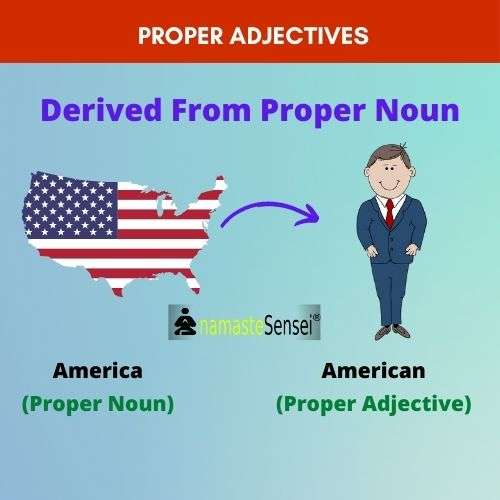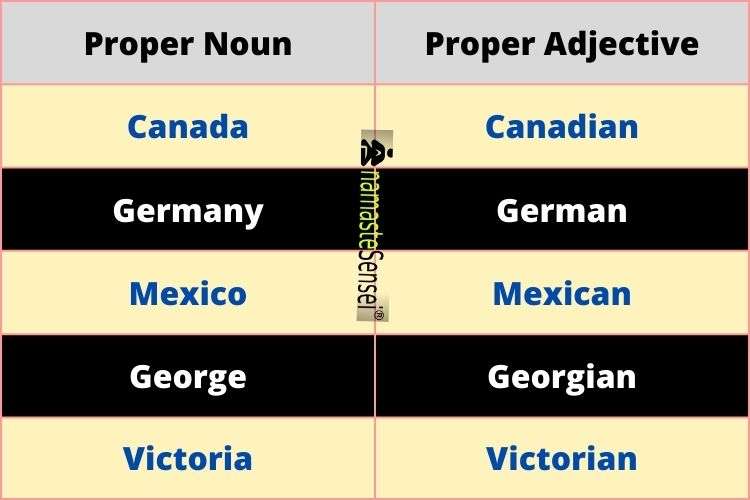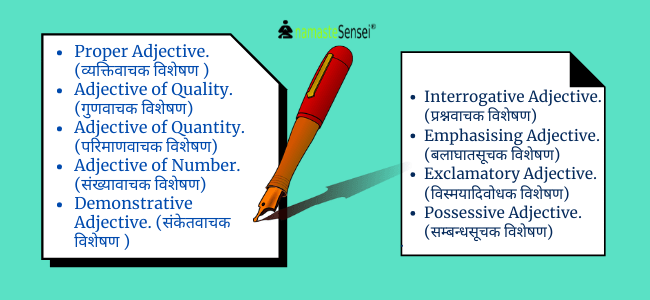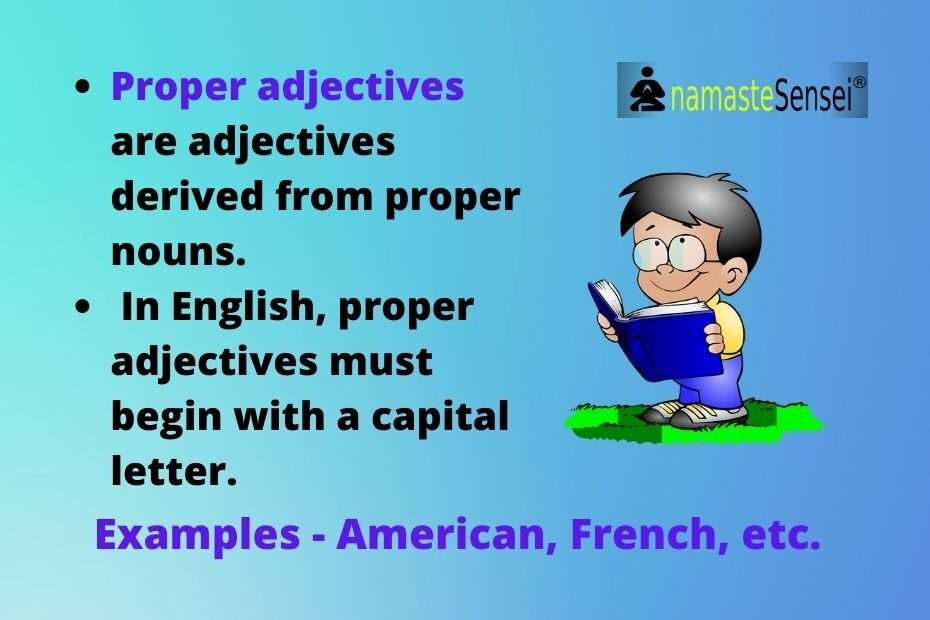-
proper adjective | Proper adjective definition

Proper adjective are adjectives derived from proper nouns. In English, proper adjectives must begin with a capital letter.
The proper adjectives in the following sentences are underlined.
- The French town has a fascinating history.
French is related to the proper noun France. - Many of my friends are American.
American is related to the proper noun America. - This house is a fine example of Victorian architecture.
Victorian is related to the proper noun Victoria.
In the above sentences as one can see all the proper adjectives (French, American, and Victorian) begin with the capital letter.
Before you read any further it might be a good idea to read about What is Proper Noun.
Recommended Read: – Proper Noun With Examples
-
What is a Proper Adjective?

Definition of proper adjective
Proper adjectives, like all adjectives, modify nouns, but they are different from other adjectives because they are actually formed from proper nouns.
|
What are nouns? A noun, we know, is the name of a person, place, or thing. We can distinguish between two types of nouns: Common nouns and Proper nouns. |
-
Formation of Proper Adjectives
- A proper adjective is usually formed by adding an ending to the noun that it is derived from. The derivation of proper adjectives from proper nouns is somewhat irregular. For instance, the spelling of the following proper nouns and proper adjectives can be compared.
| Proper Noun | Proper Adjective |
| America Canada Germany Mexico George Victoria |
American Canadian German Mexican Georgian Victorian |
- Many proper adjectives end with “an or ian” as you can see in the above table. However, other endings are also used.
Some of the Most common endings are:
- -ian
For example – “Indian” is derived from the proper noun India. - -an
For example – “German” is derived from the proper noun Germany. - -esque
For example – “Lincolnesque” can be used if you think that your neighbor resembles Abraham Lincoln. - -ese
For example – “Vietnamese” is derived from the proper noun Vietnam. - -istic
For example – “Spanish” is derived from the proper noun Spain.
- Proper adjectives are formed from these proper nouns, and they are also capitalized. They are often made from the names of cities, countries, or regions to describe where something comes from, but they can also be formed from the names of religions, brands, or even individuals.
-
Proper Adjectives for Countries
- Many proper adjectives are formed from the names of countries to describe where a person, place, or thing is from. We have seen some examples already.
- The most common endings for nationalities are -ian/-ean/-an, -ic, ese, and -ish.
- The reason that English has so many endings for different nationalities is that they are borrowed from other languages.
In below table the most common endings for nationalities are given:
-
For Cities
- Proper adjectives can also describe what city or state/province something or someone comes from. Often, these are formed without an additional ending.
For example:
| “Let’s have a New York bagel for breakfast.” |
| “She has a real London etiquette.” |
- Other proper adjectives are formed by adding an ending to the name of the city or state, but it’s impossible to learn them all. They’re very irregular. You may find it useful to learn the endings for the most famous cities of the world or the places around where you live.
Some examples of well-known proper adjectives for cities or states are:
| I will never be able to keep up with Parisian fashion. |
| There is nothing better than Alaskan smoked salmon. |
-
For Regions
Finally, we also have proper adjectives for general geographic regions. For example:
| An African elephant. |
| An Asian person. |
| A European museum. |
| A South American blanket. |
| A Middle Eastern film. |
-
Why do we use proper adjectives?
We use proper adjectives to describe something efficiently, directly, and explicitly. We could manage to avoid them, but it would result in clunky, awkward sentences. Let us see with the help of an example, what if we do not use proper adjectives in a sentence? How it may result?
| With Proper Adjective | Without Proper Adjective |
| I love Italian food. | I love food that comes from Italy. |
| How much does this Indian Jewelry cost? | How much does this jewelry that comes from China cost? |
- Sentences without proper adjectives are lengthy, awkward, and choppy to read. Usage of proper adjectives Italian and Indian makes our meaning come across much more smoothly.
|
Proper adjectives are often used in an academic or artistic context when the speaker (or writer) is addressing an audience of his or her peers and knows that they will quickly understand the reference. |
-
Proper Adjective Example in sentences
| Proper Noun | Proper Adjective | Example in Sentence |
| Africa | African | She loved the African Continent. |
| Argentina | Argentinian | The passion of Argentinian football fans knows no bounds. |
| Alaska | Alaskan | The Alaskan brown bear is a close cousin of the grizzly bear. |
| Asia | Asian | The police are trying to recruit more black and Asian officers. |
| Brazil | Brazilian | It was a great showing by the Brazilian team. |
| Britain | British | They took him to the British camp. |
| China | Chinese | She teaches foreign students Chinese. |
| Denmark | Danish | He specializes in translating from Danish into English. |
| Himalayas | Himalayan | Many wild species of the sheep and goat tribe are to be found in the Himalayan ranges. |
| Hungary | Hungarian | He became a good Hungarian scholar. |
| Iran | Iranian | We haven’t crossed the Iranian border yet. |
| Jamaica | Jamaican | I had the opportunity to paint a Native Jamaican. |
| Malaysia | Malaysian | She works at the Malaysian embassy in London. |
| Mexico | Mexican | Main Street Mexican restaurant was uncrowded on this winter evening. |
| Russia | Russian | There were two Germans and a Russian officer in the room. |
| Scotland | Scottish | A Scottish battalion was marching down the street. |
| Taiwan | Taiwanese | Taiwanese opera was a major form of entertainment in early Taiwan society. |
| Vietnam | Vietnamese | He was nicknamed Tiger after a Vietnamese soldier. |
| Zambia | Zambian | Attempted murder is a capital offense under Zambian law. |
-
Things to Remember
-
Common Noun as proper noun and proper adjective.
- There are some common nouns that can act as proper nouns in specific cases and need to be capitalized.
For example, the adjective native would normally be considered a common noun, as in the sentence.
I want to practice Spanish with a native speaker.
Here in this sentence the adjective “native“ isn’t required to be capitalized. It will act simply as a common noun.
- But Consider the word native in the following sentence.
The indigenous people of Canada and the United States are commonly referred to as Native Americans.
In this sentence, Native acts as a proper adjective because it describes a specific group of people, just like Italian or French. Hence it needs to be capitalized.
-
Prefix with proper adjective
- When a proper adjective needs a prefix, make sure to place a hyphen between the prefix and the proper adjective. Don’t capitalize the prefix.
For Example
He was accused of stirring up anti–Chinese sentiments. I love studying pre–Shakespearean theater.
-
The exception to this rule is if the prefix is formed from a proper noun itself, as in the “Austro-Hungarian empire.” In this example, both Hungarian and its prefix Austro are derived from proper nouns (Hungary and Austria), so they are both capitalized.
-
Proper Adjectives can be placed after nouns they modify
- Proper adjectives are generally placed before the noun they modify, but they can also be placed after the noun, provided that there is also a linking verb before them.
For Example
| The winning team was Spanish. |
| The man over there is Italian. |
| The monks in this monastery are Buddhist. |
All of the above sentence are correct. Spanish, Italian, Buddhist are the proper adjectives and underlined words (was, is, are) are the linking verbs.
-
other Types of Adjectives

- Proper Adjective.
- Adjective of Quality.
- Adjective of Quantity.
- Adjective of Number.
- Demonstrative Adjective.
- Interrogative Adjective.
- Emphasizing Adjective.
- Exclamatory Adjective.
- Possessive Adjective.
Recommended Read: Types Of Adjectives with Examples
Congratulations, you have read the complete article. If you have any doubts or queries, feel free to comment below. We will respond as soon as possible.
Or Email Us At [email protected]
More Articles:
| Types of adjectives | What are adjectives? |
| Adjective of Quantity | Adjective of Quality |
| Adjective of Number | Interrogative Adjective |
Any topic you want us to cover. Let us know.
